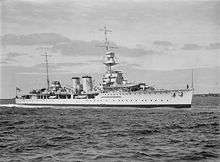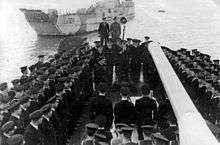HMS Danae (D44)
.jpg) HMS Danae underway, August 1943 | |
| History | |
|---|---|
| Name: | HMS Danae |
| Builder: | Armstrong Whitworth |
| Laid down: | 1 December 1916 |
| Launched: | 26 January 1918 |
| Commissioned: | 22 July 1918 |
| Decommissioned: | 4 October 1944 |
| Fate: | Transferred to Poland |
| History | |
| Name: | ORP Conrad |
| Namesake: | Józef Konrad Korzeniowski |
| Commissioned: | 4 October 1944 |
| Decommissioned: | 28 September 1946 |
| Fate: | Returned to Royal Navy |
| History | |
| Name: | HMS Danae |
| Recommissioned: | 28 September 1946 |
| Decommissioned: | 22 January 1948 |
| Fate: | Scrapped 27 March 1948 at Barrow |
| General characteristics | |
| Class and type: | Danae-class light cruiser |
| Displacement: |
|
| Length: | 445 ft (136 m) |
| Beam: | 46.5 ft (14.2 m) |
| Draught: | 14.5 ft (4.4 m) |
| Propulsion: |
|
| Speed: | 29 knots (54 km/h; 33 mph) |
| Range: |
|
| Complement: | 462 |
| Armament: |
|
| Armour: |
|
HMS Danae, during the latter part of World War II commissioned as ORP Conrad, was the lead ship of the Danae-class cruisers (also known as the D class), serving with the Royal Navy between the world wars and with the Polish Navy during World War II.
Service
Danae was laid down on 1 December 1916 in the Armstrong Whitworth Shipyard in Walker-on-Tyne and launched on 26 January 1918. The lead ship of her class, she was one of the fastest cruisers of her time. Propelled by two Brown-Curtis steam turbines of 40,000 HP, 6 boilers and 2 propellors, she could travel at 29 knots (54 km/h; 33 mph). With 1,060 tons of oil in her tanks, she had a range of 1,480 nautical miles (2,740 km; 1,700 mi) at 29 knots and 6,700 nautical miles (12,400 km; 7,700 mi) at 10 knots (19 km/h; 12 mph). She was also well armoured, with the sides and the command deck protected with 3 inches (76 mm) of reinforced steel, the tanks and munition chambers with 57 millimetres (2.2 in), and the main deck with 2 inches (51 mm).
Attached to the Harwich-based 5th Light Cruiser Squadron, she took part in several North Sea patrols during the last months of World War I. Between October and November of the following year, she passed to the Baltic Sea, where she supported the Whites in the Russian Civil War, along with her sister ships Dragon and Dauntless. In February 1920 she was attached to the 1st Light Cruiser Squadron of the Atlantic Fleet.
World cruise

In 1923 she was attached to the Special Service Squadron, a naval fleet created for propaganda purposes. The flotilla consisted of the battlecruisers Hood, Repulse and the cruisers Delhi, Dragon, Dauntless and Dunedin, as well as 9 other ships (mostly destroyers), and was bound on a journey around the world. The Squadron left Devonport on 27 November and headed for Freetown in Sierra Leone. Then the task force visited Cape Town, Port Elizabeth, East London and Durban, to where she arrived the last day of the year. The following day the Squadron left for Zanzibar, then visited Trincomalee, Singapore, Albany, Adelaide, Melbourne, Hobart and Sydney, from where she left for Wellington in New Zealand. She left the port in May and on 16 May paid a short visit to Suva and Samara on Fiji, then to Honolulu (6 June), Victoria (25 June), Vancouver and then San Francisco (until 11 July). There the Squadron was split and the light cruisers headed for Great Britain through the Panama Canal and various ports in South America, including British Guyana, Antilles and Jamaica.
Transferred to the Mediterranean, between 1927 and 1929 Danae served as an escort of the 1st Cruiser Squadron, after which she was withdrawn to Great Britain for refurbishment and modernisation. In 1930 she returned to active service and was attached to the 8th Cruiser Squadron stationed in the British West Indies. In 1935, at the outbreak of the Second Sino-Japanese War, she escorted various evacuation convoys from Shanghai to Hong Kong and was fired at by the Japanese Navy.
Second World War
After completing her duties in the Far East, Danae was again moved to Great Britain and placed in reserve. Mobilized in July 1939, she was attached to the 9th Cruiser Squadron, initially operating in the South Atlantic and then the Indian Ocean from October. On 23 March 1940 she was attached to the Malaya Force and took part in various patrols in the area of the Dutch East Indies and Singapore. On 20 January she was attached to the China Force and started to escort convoys in the Yellow Sea and between the Dutch Indies and Ceylon, together with the cruisers Durban, Dauntless, Cornwall and the Australian HMAS Canberra. On 24 February she arrived in Batavia and then went on to Colombo, from where she was withdrawn to Cape Town for refurbishment.
She returned to active service in July 1943, after 11 months in the shipyard. In March 1944 she returned to Great Britain and was attached to the 1st Cruiser Squadron. Prior to the Invasion of Normandy she left for the Sword Beach area, where she carried out ground support missions, together with the battleships Ramillies, Warspite, cruisers Mauritius, Frobisher, Arethusa and the Polish ORP Dragon, as well as 10 S-class, V-class and Hunt-class destroyers. In July the squadron moved to the area of Port en Bessin and Ouistreham only to return to Great Britain in August. Withdrawn from active service, she was used as a hulk in the port of Plymouth.

After the loss of ORP Dragon, on 4 October she was leased to the Polish Navy. A sister ship of ORP Dragon, she was manned mostly by the surviving part of her crew. Commanded by Cmdr. Stanisław Dzienisiewicz, she was refurbished in Southampton and then Chatham until 23 January 1945. Initially the ship was to be renamed to either "ORP Wilno" or "ORP Lwów", after the cities of Wilno (Vilnius) and Lwów (Lviv). This was seen as controversial because although the cities were part of Poland until after the war, they were at that time claimed by the Soviet Union, and the British authorities did not wish to offend the Soviets. It was decided to use the politically neutral name of ORP Conrad, after Józef Konrad Korzeniowski, better known under his English pen name of Joseph Conrad. In February, the ship moved to Scapa Flow, on 2 April she was attached to the 10th Cruiser Squadron (comprising Birmingham, Bellona, Diadem and Dido), but was again withdrawn for repair of damaged turbine a week later. She left the shipyard only on 30 May, three weeks after war in Europe ended. Attached to the 29th Destroyer Flotilla (comprising Zodiac, Zephyr and Zest), she was briefly stationed in the port of Wilhelmshaven, the main base of the Kriegsmarine recently captured by the Polish 1st Armoured Division.
Until the end of 1945 she served as a transport ship, transporting Polish Red Cross help to Norway and Denmark. In January of the following year she returned to Rosyth for good, from where she carried out training tasks with ships of the Polish Navy, including: ORP Burza, ORP Błyskawica, ORP Piorun and ORP Garland. On 8 March 1946 the ships were decommissioned from the Home Fleet and the Polish crews began preparing to hand them back to the British. By August the ship's crew was reduced to 50% and on 28 September she was returned to the Royal Navy. Renamed back to Danae she was taken over by the Care & Maintenance Party and moved to Falmouth. On 22 January 1948 she was sold to Thos W Ward and scrapped following 27 March 1948 in the Vickers Armstrong shipyard in Barrow-in-Furness.
References
- Colledge, J. J.; Warlow, Ben (2006) [1969]. Ships of the Royal Navy: The Complete Record of all Fighting Ships of the Royal Navy (Rev. ed.). London: Chatham Publishing. ISBN 978-1-86176-281-8. OCLC 67375475.
- Jane's Fighting Ships of World War One (1919), Jane's Publishing Company
- U-boat.net
External links
| Wikimedia Commons has media related to |
- D class cruisers
- Danae class light cruisers
- Pictures of HMS Danae / ORP Conrad
- Details and history of the Danae class cruisers (in Polish)
- Silhouette of ORP Dragon and ORP Conrad
- Drawings of ORP Conrad
- ORP Conrad after refit in 1943